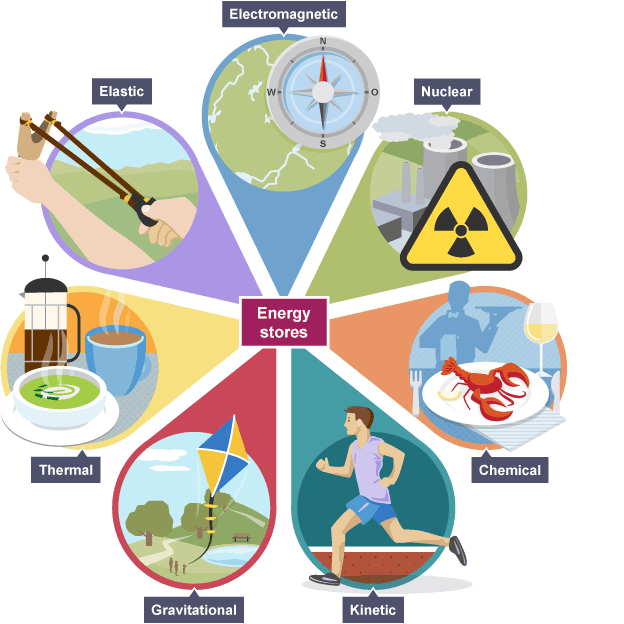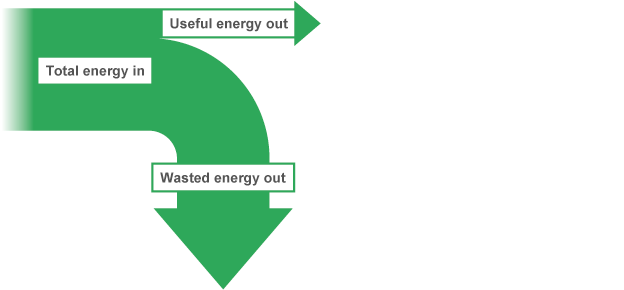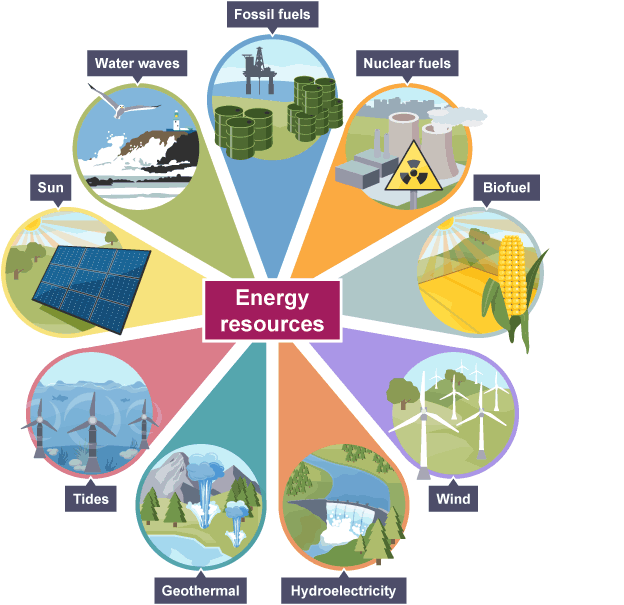Sustainable Energy (OCR)
Energy Stores
Energy can be stored in a variety of ways. Heat and work both involve the transfer of energy from one thing to another.
A few examples of conventional energy stores are:
Gravitational potential: hydroelectric power is produced by storing energy in water at the summit of a mountain.
Kinetic energy: In a hybrid vehicle, flywheel energy is used in place of conventional batteries.
Thermal energy: During the day, the energy contained in a night storage heater's concrete blocks is released.
Nuclear energy: a uranium atom's nuclear fission releases the energy that has been stored in its nucleus.
Chemical energy: electrical current is used to power household appliances by transferring the energy contained in a battery's chemicals or a power plant's fuel.

Energy Transfer
Energy is transferred when a thing undergoes work. Power is the rate at which this energy is transported. Thus, a gadget will transfer more energy per second the more powerful it is. When examining the overall cost of electricity consumed as displayed on an electrical bill, this is significant.
Calculating the Transferred Energy
Seconds and Joules
One can calculate the energy transferred using:
power × time = transferred energy
Calculating the Electrical Power
Power

A device's power output rises if:
More energy is moved in a specific amount of time.
a shorter time is needed to transfer the same amount of energy.
A joulemeter can be used to measure the energy transferred by an electrical device. If the amount of time a device is turned on is also recorded, the power output of the device can be computed.
Hours and Kilowatt-hours
An energy supplier's electric bills display the energy consumed in kWh as opposed to J or kJ.
To this day, the transmitted energy is computed using:
power × time = transferred energy
However:
Kilowatt-hours, or kWh, are used to measure energy transported.
Power is expressed in kW, or kilowatts.
The unit of time is hours, or h.
Energy Conservation
Energy is constantly conserved because it can never be created or destroyed. This implies that energy is constantly moved between stores, however occasionally it is deemed to have been "wasted" when it is moved to an unusable store.
All of the energy in the universe was there at the Big Bang and will remain until the end of time since energy is always conserved.
Examples of Energy Conservation
The Skydiver
The following energy transfers occur when a skydiver jumps out of a plane:
As the skydiver's altitude drops, so does their gravitational potential energy.
As the skydiver's speed increases, so does their kinetic energy reserve.
Because of the friction that exists between the skydiver and the air particles, the thermal store of the air and the skydiver increases.
Mobile Phones
A battery that stores chemical energy is a component of every smartphone. During the operation of a smartphone, the following energy transfers occur:
An electric current is used to transfer the chemical energy stored in the battery to light the screen and create music.
Visible radiation is released by smartphones when they emit light.
A vibrating speaker produces sound waves.
Additionally, the battery's chemical energy is converted to thermal energy, which explains why phones warm up when in operation.
Dissipation
Dissipation is a term that's frequently used to characterize energy waste. Since energy is typically lost to the environment, it is considered wasted when it is not converted to usable energy reservoirs.
Energy Dissipation via Thermal Energy
When two surfaces in a mechanical system, such as a conveyor belt, rub against one another, energy is lost. Friction is fought, leading to the two surfaces becoming heated.
Instead of energy being efficiently transported, it dissipates as the surface's thermal energy store grows. Because there is less friction between the surfaces, less energy is lost.
Energy efficiency is typically higher in newer electrical products than in older ones.
For instance, compared to filament lamps, LED light bulbs are more energy-efficient because light transfers a greater percentage of the electrical energy store to the environment as opposed to heating.
Dissipation via Sound Energy
Electrical effort in a tumble dryer is converted into usable thermal energy that aids in drying garments. However, vibrations—which we refer to as sound waves—dissipate energy. Tumble dryers can make a lot of noise for this reason.
Moreover, highly noisy electrical generators. As the generator rotates, vibrations release some of the stored electric and magnetic energy. Sound is the vibrations that we perceive.
Thermal Insulation
In the summer, buildings can feel too warm, and in the winter, too chilly. Summertime brings energy from the warmer outside world into the building.
Energy moves from a structure into the colder winter environment. Since maintaining a building's warmth is expensive, efforts are made to slow down the rate at which energy is removed through heating.
Thermal Conductivity
The rate at which energy moves through a material when heated is determined by its thermal conductivity:
Heat is rapidly transferred by a substance with a high thermal conductivity.
Low thermal conductivity materials can be utilized as thermal insulators since they transfer energy slowly.
Reducing the transfer of unwanted energy
There are primarily two approaches to lessen undesired heat-related energy transfers:
employ insulators made of materials with low thermal conductivity
use thicker materials
A few methods for achieving this in houses and other buildings are listed in the table:

Efficiency
An electrical device's efficiency is dependent upon:
The amount of energy lost and sent to unwanted stores
The amount of energy that is converted to useful stores
A device is less efficient the more energy it wastes. Use the following equation to determine efficiency:

Increasing efficiency - Greater
Fuel is used less by efficient devices than by less efficient ones. Because there is less wastage of the supplied energy reserve, they can run at a lower power.
Enhancing efficiency can be achieved by:
creating machinery and gadgets with materials that limit undesired energy transmission.
advancing the technology employed; for instance, contemporary LEDs are far more energy-efficient than conventional filament lights.
utilizing insulation to stop the environment from losing thermal energy.
Sankey Diagrams
Sankey diagrams illustrate how energy moves through a system:
The system's entire energy input is represented by an arrow.
This arrow divides into smaller arrows to display further transfers.
When the quantity of energy in each of the energy sources is known, Sankey diagrams are most helpful. To indicate the amount of energy, the width of the arrow is depicted to scale.
Moreover, the total energy introduced into a system is the sum of the energy dissipated, or "wasted," and the useful energy transmitted. This attests to energy conservation.

Energy Resources
The world's energy resources differ substantially in the quantity of energy they can store. One kilogram of naturally occurring uranium, for instance, has the same energy content as 14 000 kg of coal.
Renewable and Non-renewable
Renewable energy is energy which can be replenished as it is used (e.g. wind will never stop). Non-renewable energy is used more for large-scale energy supplies due to the large energy output per kilogram of fuel
Replenishing renewable resources can be achieved through:
Human action: new trees are planted to replace those that are chopped down for biofuel.
Natural processes: the water cycle replaces water that is allowed to pass through a dam to generate hydroelectricity.
An energy resource that has a limited supply is considered non-renewable. When all reserves are depleted, it will finally run out.
Different energy sources
The most widely used energy resources of today are displayed in the table below.

Comparing Resources
Nuclear or fossil fuel-powered power plants are incredibly dependable energy sources. The majority of the nation's electricity is produced by these two kinds of stations. They run practically nonstop.
Gas power plants and hydroelectric power plants are typically employed when more power is required since they can be turned on quickly and begin producing electricity practically instantly.
Nuclear power plants require relatively inexpensive fuel, but the facilities themselves are costly to construct. At the end of their useful lives, outdated nuclear power plants must be dismantled, or decommissioned, at a considerable cost. Additionally, the highly radioactive waste must be stored for millions of years until natural activity will return to a safe level.
Because of how the moon affects the tides and how rainfall fills reservoirs, water power sources like hydroelectricity and tidal power are dependable and predictable. To meet extra demand, these two can also be employed.
However, a lot of renewable energy sources, including wind and solar power, are erratic and unable to meet rising demand because sunny and windy conditions are not always assured. Fuel costs are zero for renewable resources, but building the necessary equipment is costly.
Electricity Generation
Power station generators generate energy by subjecting a coil of wire to a fluctuating magnetic field. A magnet revolving inside the coil is what's causing this fluctuating magnetic field.
Nuclear and fossil fuel power plants utilize the energy store to heat water and create steam, which turns a turbine that is attached to the magnet and causes it to spin.
The generator is immediately connected to additional energy sources.
The National Grid
Power plants produce electricity, which is then distributed throughout the United Kingdom by the National Grid.
To transfer energy throughout the National Grid:
'Step-up' transformers are used to transport electrical electricity at high voltages, up to 400,000 V or 275,000 V, before it leaves a power plant.
'Step-down' transformers lower the voltages to 33,000 V for large industries, 11,000 V for medium factories, and 230 V for homes, stores, small factories, and offices before electrical power enters homes and factories.
The grid is a particularly efficient means of transferring electrical energy. Higher cable currents cause more energy to be lost to heat in the surrounding area. Electrical power is moved across the grid at a high voltage and a low current since high currents waste more energy than low currents.
Mains Electricity
The energy that is delivered to people's homes is referred to as mains electricity.
Household energy input is ac since the National Grid is limited to using ac input. This indicates that there are 100 times per second variations in the voltage and current directions. A direct current (dc) voltage, such the one generated by a battery or cell, has a constant direction.
Main wires having live, neutral, and earth
Plugs are used to connect household appliances to the mains supply in the UK. The live, neutral, and earth wires are the three wires that make up the plug.
The two wires in a plug—the neutral wire, which is blue, and the live wire, which is brown—form the entire circuit with a household device. The earth wire, which comes in green and yellow colors, is included as a safety wire even though it is not typically used in circuits. It is linked to "earth," which is typically a big metal spike buried beneath a dwelling.
Energy Needs
Energy is needed for almost everything, and it can be used by moving it from one energy store to another. Energy resources are systems with a lot of energy storage capacity.
The main forms of energy that can be used to generate electricity include solar energy, wind, hydroelectricity, geothermal, tidal, and water waves. Nuclear fuel and biofuel are also accessible.
All of the energy that exists on Earth ultimately originates from the Sun, although it has been stored in various forms.
Energy is required in
Houses: to run appliances, heat, and cook
Public services, such as schools and hospitals, are operated by people who operate heavy machinery, heated rooms, factories, and manufacturing chains.
Transportation: some trains and trams are connected to an electricity supply, and buses, trains, vehicles, and boats all require a fuel source.
However, the environment may be harmed by the production and distribution of power. Certain stores produce hazardous waste products and pollutants when they release energy. Burning fossil fuels releases sulfur dioxide, which results in acid rain, and carbon dioxide, which intensifies the greenhouse effect.
Use trends and patterns for energy resources
The amount of fossil fuels harvested and burned increased significantly throughout the Industrial Revolution due to developments in automation and transportation.
The 20th century saw the development of electricity as a practical energy distribution method for a variety of appliances and uses, including heating, lighting, computing, and industrial operation.
The seasons and times of day have an impact on the demand for energy. People use a lot of energy in the early evening for cooking, heating, and lighting, but relatively little energy is used during the night as they sleep. Compared to the summer, winter requires more lighting and heating.
Worldwide Energy Usage
Fossil fuels continue to generate the majority of the electricity produced worldwide. This results in part from:
When compared to alternative energy sources like wind and ocean waves, fossil fuels have a higher power output.
Because of the current infrastructure for their extraction, transportation, and processing, fossil fuels are more affordable than building new alternatives.
The majority of nations believe that cutting back on fossil fuel consumption is necessary to minimize greenhouse gas emissions that fuel climate change.
Because burning fossil fuels has been shown to have negative effects on the environment, science and society have developed ways to employ renewable energy sources and increase the efficiency of machinery.
Nuclear power plants are becoming a more common source of electricity generation in some wealthy nations. Compared to fossil fuels, nuclear fuel may release significant amounts of energy and produce no carbon dioxide. However, it is challenging to store and dispose of the radioactive waste that is created.
The decisions made by governments regarding the utilization of energy resources may also be influenced by political and economic issues. For instance, nations like Saudi Arabia, whose economies are mostly dependent on the extraction and export of oil, are very interested in using fossil fuels to generate energy.
A high-power production is necessary for developing nations like China to maintain industrial growth and remain competitive with more developed nations. This indicates that they'll probably keep utilizing fossil fuels and advance nuclear power.